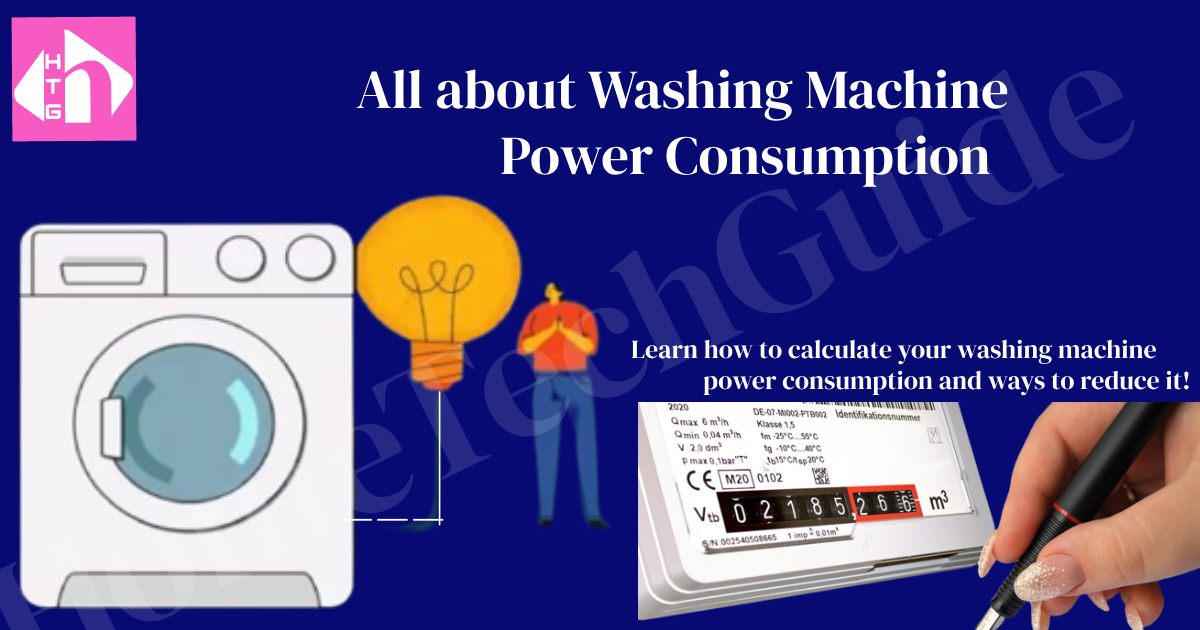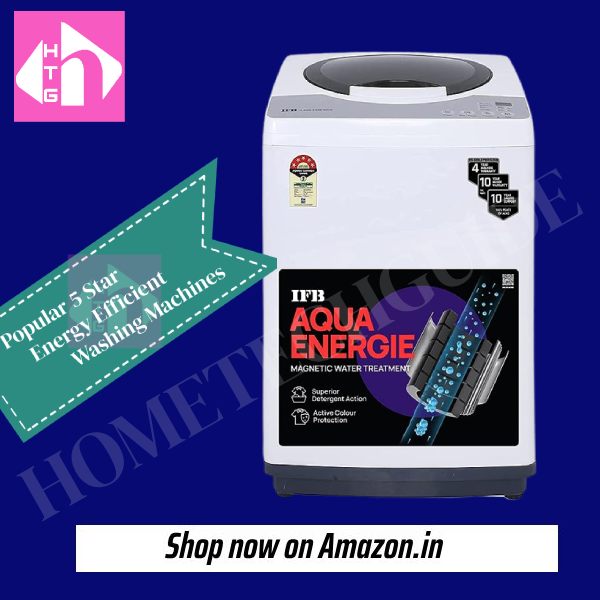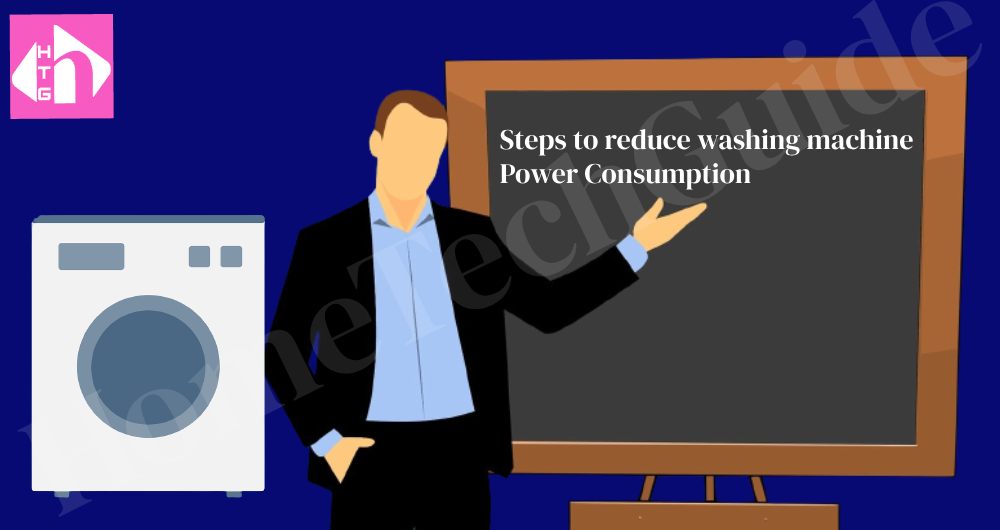Washing machine power consumption is a fixed thought in the users’ minds. It may not reflect every time we operate the washing machine, but the contribution of washing machine wattage to our monthly electricity bill definitely makes a stance in our body posture 🙂

In this article, we will learn how to calculate the power consumed by your washing machines and ways to reduce it.
Washing machines come with some stickers that tell about power rating and other technical specifications of the washing machines. Let’s start by understanding these codes first.
Understanding Washing Machine Power Consumption stickers
A new washing machine comes with two stickers that talk about the power consumption by the washing machine.
- Washing Machine wattage sticker
- BEE rating sticker ( Only available with 5-star energy efficient washing machines)
Let us understand how these stickers help get a washing machine power consumption idea.

Washing machine wattage in India
This sticker is usually found on the back panel. It talks about washing machine power rating, washing machine model number and a few other specifications.
As we see in the image above, the rated input is 360 W at 230 V (W= Watts, V= Volts). It says that this washing machine’s power consumption is 360 watts per hour.
To find the washing power consumption in units, we need to follow the below given steps:
Choose a wash cycle, and note the time the control panel displays for this wash cycle completion. For Instance, Assume:
The wash cycle chosen is Daily wash
Time displayed = 55 Minutes
For calculation convenience, let’s assume it to be 1 hour.
Now the electricity we pay is in terms of Kwh, where 1 Kwh means 1 Unit.
Now we have Watt= 360
we have hour= 1
Therefore, the total Watt that will be consumed in 1 hour = 360 x 1
= 360 Watts
Now, let us convert it into Kwh = 360/1000
= 0.36 Kwh
Since 1 Kwh= 1 Unit, 0.36 Kwh =0.36 Unit
Now let’s assume the per unit rate is Rs. 7
So for 0.36 units, you need to pay = 7 x 0.36
= Rs. 2.52
This Implies that if you use your washing machine for 1 hour on an average, for 15 days in a month, then your washing machine power consumption in a full month of 30 days would be:
0.36*15
= 5.4 KWh
and the cost you need to pay would be
5.4 x 7
= Rs 37.8
That’s how we can calculate washing machine power consumption, based on the washing machine wattage rating.
Now let us talk about the second sticker: The BEE Energy efficiency rating sticker.
A clear understanding of this sticker would help to understand the 5 star washing machine power consumptions.

5 Star Washing Machine Electricity Consumption
The BEE rating stickers on a 5 Star washing machine shows electricity consumption per Kg per Cycle (Unit or Kwh/Kg / Cycle). The sticker displayed above shows it to be 0.0120 kWh for a Whirlpool washing machine.
(Energy consumption= 0.0120 Kwh/ Kg/ Cycle)
You may consider it as a standard figure for the washing machine it is pasted on, and multiply the load (Kg) that you are about to wash to get the washing machine power consumption estimate.
However, you may refer to both the BEE and the back panel sticker that shows power rating for the washing machine in watts. Referring the two stickers together will give a clear picture of power consumption by a washing machine.
Here are a few best selling 5 star energy efficient washing machines that you may refer to learn more.
Some Best Selling BEE 5 Star Washing Machines




Now, let us move to the other part where we will learn about the factors that affect the washing machine power consumption. Learning about these factors will help you make your washing machine more efficient.

10 Factors that affects the Washing Machine Electricity Consumption
We will discuss 10 factors that affect the electric consumption of a washing machine.
Let’s discuss those points and understand the facts associated with them.
1. BEE rating
The first thing that affects the power consumption of a washing machine, or any other appliance, is its energy efficiency rating. Home appliances come with an energy efficiency rating provided by the Bureau of Energy Efficiency (BEE), India. The machine’s efficiency is rated on a scale of 5 stars; 5 stars being the most efficient. So the first thing we need to do is to buy only the 5-star energy efficient washing machine.
Now let us move to the other factors that are like hidden factors, and directly or indirectly affect the washing machine power consumption.
2. Size of the washing machine
The larger the washing machine the more energy it will require to operate, and hence will consume more electricity. So knowing what size of washing machine you need thus becomes important first. Always buy a washing machine of the size that is your actual need, buying a larger washing machine will silently keep taking money out of your pocket in the form of an electricity bill for, no use. For Instance:
An 8 kg washing machine will consume more electricity for the time it runs as a 6 Kg washing machine.
3. Type of cycle
Navigate through the different wash cycles and you will see that the digital indicators in your washing machine panel indicate the different times for different wash cycles. This time is the motor run time. It does not take into account the time required for water filling. Hence it is clear that the more time the motor runs, the more energy your washing machine consumes. So choose a wash cycle that is the actual need of your laundry.
For example, a heavy-duty wash cycle will use more energy than a daily wash cycle, making an increase in your washing machine power consumption.
4. Use of heater
I am mentioning it at no. 4 but this is the largest energy efficiency factor among all.
Go through the specification of your washing machine and you will see the heating element wattage. Front-load washing machines usually come with a heating element that consumes 2000 watts of electricity per hour at full heating capacity.
This means that if the washing machine allows the use of a heater till 90 degrees centigrade, it will consume electricity @ 2000 watts per hour, for the fraction of time you use the heater. It is similar to heating the water in a bucket and then using the washing machine with that hot water. Both will have their own cost of usage.
Solution: Use the heater in the washing machine wisely.
If you need a wash at 30 degrees centigrade, please do not heat the water to 60 degrees or 90 degrees centigrade.
5. Type of washing machine
If you wash your clothes in normal tap water, in other words- if you do not use the heater; Front load washing machines are more energy efficient than the top load washing machines. Hence using a front loader will save electricity.
6. Load size
Washing machines are designed to operate at certain conditions, and they give the best result if used under those conditions. For instance, washing machine brands guarantee efficiency as per their lab test reports.
Those lab tests are done in the ideal conditions, and the ideal conditions certainly mean the parameters/ factors that the machine has been designed for. Thus, washing machines consume less energy when operated at full loads. For partial loads, the machine uses more energy as it has to work harder to wash the smaller loads.
7. Age of the machine
New washing machines have been found more efficient in terms of energy saving than the old ones. This is primarily due to enhanced technology in the new washing machines. Also, the washing machine parts are in better condition and consume close to the rated efficiency.
8. Use frequency
The more a washing machine is used, the more energy it will consume. Hence it is suggested not to wash partial loads frequently. Better accumulate the clothes and try using your washing machine at full load capacity.
9. Type of detergent
Better detergents may loosen the stains on the fabric without the use of a heater. Hence they result in considerable energy savings.
For Instance; Samsung washing machines’ recent models come with Eco-bubble technology where the washing machine makes a unique attempt to create extra foams that penetrate through your laundry and loosen the stains. If used with the right quality detergent, you may not need to use the heater to loosen a not-so-hard stain.
10. Location of Installation
Incorrect installation or placing the washing machine in a poorly ventilated area may also increase the electricity consumption of the washing machine.
Wrapping Up:
Washing machines are an important part of our lives today. It reduces our daily tasks to a considerable extent, and most of us wouldn’t imagine a life without it. But all these comforts do not come for free.
There is a minimum cost that we need to pay for using a washing machine regularly. We pay this cost in terms of electricity bills and the maintenance cost of the washing machine.
With the above factors that affect the electricity consumption of a washing machine and the detailed explanation to calculating washing machine power consumption, we hope that you found the report useful.
Since we are talking about efficiency and saving, we would suggest giving due consideration to the brand reliability and the post-sales services record of the washing machine brand.
Thank You.
